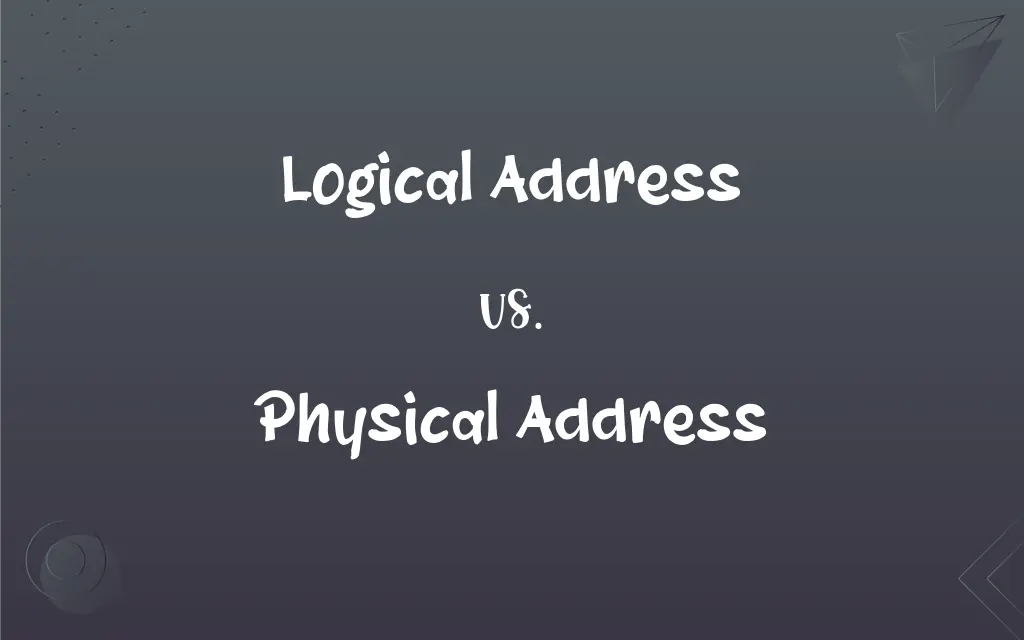Logical Address vs. Physical Address: What's the Difference?
Edited by Aimie Carlson || By Harlon Moss || Updated on October 25, 2023
A logical address is generated by a CPU during a program's execution, while a physical address refers to a location in a computer's memory hardware.

Key Differences
A logical address is created and used by a Central Processing Unit (CPU) when a program is being executed. This address, often called a virtual address, represents a location from the program's perspective. On the other hand, a physical address pertains to the actual hardware memory location in the system, where data or instructions are stored.
The concept of a logical address is crucial for systems that utilize virtual memory. Such systems allow programs to run as if they have access to a larger memory space than what's physically available. Contrarily, the physical address ensures that the system knows where exactly in the memory the required data or instruction is located.
Mapping between a logical address and a physical address is commonly achieved using memory management techniques, such as paging or segmentation. This mapping ensures that even if a program thinks it's accessing a specific location (logical address), the system redirects it to the correct physical address where the content is actually stored.
Logical addresses ensure a level of abstraction, providing flexibility and security. It allows programs to operate without needing to know physical memory details. Conversely, physical addresses provide the concrete locations within the hardware where the system reads or writes data.
The distinction between logical address and physical address is fundamental in modern computer systems. While the logical address offers a program's perceived memory location, the physical address pinpoints the actual hardware location where that piece of data or instruction resides.
ADVERTISEMENT
Comparison Chart
Definition
Address generated by CPU during a program's execution
Actual location in computer's memory hardware
Purpose
Provides abstraction for program execution
Specifies exact location of data in memory hardware
Usage
Employed in systems with virtual memory
Used by memory hardware to access data
Dependency
Relies on mapping mechanisms to convert to physical addresses
Independent and directly corresponds to hardware
Security and Flexibility
Offers abstraction for enhanced security and flexibility
Provides direct, unabstracted hardware access
ADVERTISEMENT
Logical Address and Physical Address Definitions
Logical Address
Represents a program's perspective of memory.
From the program's view, it accesses data at a logical address.
Physical Address
A physical address refers to a specific location in memory hardware.
The data is stored at the physical address 0x1A2B in RAM.
Logical Address
A logical address is a virtual memory location used by programs.
The program uses the logical address to reference its data.
Physical Address
Represents the tangible storage location in a computer system.
The cache memory fetched the data from the designated physical address.
Logical Address
It provides an abstract view of memory for programs.
The program, unaware of the actual memory layout, uses the logical address.
Physical Address
It's the actual memory location of data or instructions.
The CPU retrieves instructions from a given physical address.
Logical Address
Logical addresses need mapping to access actual memory.
The memory management unit maps the logical address to a physical one.
Physical Address
Directly accessed by the memory hardware without abstraction.
The memory chip uses the physical address to read or write data.
Logical Address
Logical addresses are generated by the CPU during program execution.
The CPU creates a logical address for each memory request.
Physical Address
It's where the content specified by logical address resides.
The logical address maps to a specific physical address in the memory.
FAQs
Why is the distinction between logical address and physical address important?
It allows for abstraction in memory management, enhancing flexibility and security.
How is the conversion from logical address to physical address achieved?
Through memory management techniques like paging or segmentation.
Do all computer systems use both logical and physical addresses?
Most modern systems do, especially those utilizing virtual memory.
How does a computer system use a physical address?
A physical address is used to pinpoint the exact hardware location in memory to access data.
Is a logical address the same as a virtual address?
Yes, a logical address is often referred to as a virtual address.
Can a program directly access the physical address?
Typically, programs deal with logical addresses, and the system handles the mapping to physical addresses.
What's the main purpose of a logical address?
A logical address provides an abstract memory location for program execution.
Is the range of logical addresses the same as physical addresses?
Not always. Logical address space can be larger than physical address space due to virtual memory.
What happens when the logical address space exceeds physical address space?
Portions of memory can be swapped between RAM and storage devices to manage the discrepancy.
Why is abstraction through logical addressing beneficial?
It offers security, flexibility, and allows programs to operate without knowing actual memory details.
In a memory hierarchy, where are physical addresses primarily used?
Physical addresses are used at the lower levels of memory hierarchy like RAM and caches.
What happens if the mapping from logical to physical address fails?
It may result in a page fault, prompting the system to fetch the required data from secondary storage.
Do operating systems manage the mapping between logical and physical addresses?
Yes, OSes play a crucial role in managing memory and address mapping.
Can users or programmers directly modify the physical address space?
Direct modification of physical address space by users is usually restricted to ensure system stability and security.
Do logical addresses always map to the same physical addresses?
No, the mapping can change, especially in systems with dynamic memory management.
What role does the Memory Management Unit (MMU) play regarding addresses?
The MMU is responsible for converting logical addresses to physical addresses.
Are logical addresses continuous?
Not necessarily. With techniques like paging, non-contiguous logical addresses can map to contiguous physical addresses.
Can multiple logical addresses map to a single physical address?
Typically, one logical address maps to one physical address, but reverse isn't always true.
In embedded systems, how common is the use of logical addresses?
Embedded systems often work directly with physical addresses due to their specific and optimized nature.
Can memory access speeds differ based on logical or physical addressing?
Yes, accessing data through logical addresses (which require mapping) can introduce slight delays compared to direct physical addressing.
About Author
Written by
Harlon MossHarlon is a seasoned quality moderator and accomplished content writer for Difference Wiki. An alumnus of the prestigious University of California, he earned his degree in Computer Science. Leveraging his academic background, Harlon brings a meticulous and informed perspective to his work, ensuring content accuracy and excellence.
Edited by
Aimie CarlsonAimie Carlson, holding a master's degree in English literature, is a fervent English language enthusiast. She lends her writing talents to Difference Wiki, a prominent website that specializes in comparisons, offering readers insightful analyses that both captivate and inform.
































































